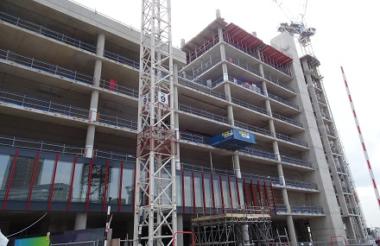On Wednesday afternoon, the construction of International Quarter building in East London’s Olympic Park where Cancer Research UK and the British Council will soon be residents reached its highest point.
While the £2.4bn Stratford development is some way off completion, CRUK is set to move from its current Angel office next year, with the British Council expected to move from its St James's Park headquarters in 2020.
Some eyebrows have been raised at the trend of charities moving from central London to Stratford, with Unicef set to join Scope at the nearby Here East campus.
And it is not just charities heading east, with Transport for London and the Financial Conduct Authority also moving their headquarters to Stratford.
Speaking at the Charity Property Conference on Tuesday, Jonathan Vanstone-Walker, director at property firm TSP, said these organisations had been made to consider moving in the first place due to increasing rents in central London.
However, he said Stratford is not the cheapest area in Outer London, nor is it the best connected.
He said: “Quoting rents at the international quarter at the moment are £47.50 a square foot. You could probably go to anywhere in Canary Wharf and get some decent office space for less than that.
“We do transport assessments for our clients when they are thinking about where they want to move and Stratford never shines out as being the best connected place.
“Yes it has got high-speed and it has got the Crossrail, but it is still a bit of a journey for people. They are still commuting to another station and moving out into that market.
Why the move?
Vanstone-Walker said part of the reason charities have chosen these new developments in Stratford is the ability they have to provide a modern workplace.
He said: “The big open plan floor plates in the new buildings allow organisations to adopt agile working. In doing so, they can actually reduce the amount of floor space they are taking up.
“Rather than having 20 or 30,000 square foot of floorplates over multiple floors, you are in one big floorplate and you are taking less space.”
At the “topping out” celebration on Wednesday, CRUK chief information officer Tiffany Hall said these larger open spaces would enable more cross-departmental working.
“Great things happen when our different teams across CRUK interact, so the more that we can work across the charity functions, the better.
“We will create spaces on these wonderful, wide-open floorplates, where our fundraisers can connect with our research colleagues, and thereby help our supporters to connect the research and inspire them further with the critically important nature of our work.”
However, Hall admitted that the original decision to move from Angel to Stratford was “a commercial one”.
Hilary Cross, global marketing director at the British Council, said her charity would use the larger floorplates to host events and exhibitions. She said their offices will be designed to include both “creative playground spaces” and “quiet work areas”.
Another big draw for the British Council, as a culturally-focused charity, is the opportunity to collaborate with its future neighbours the London College of Fashion and the V&A, which will both open offices in Stratford, as well as with CRUK.
She said: “Surrounded by culture, by education in the heart of a multi-cultural and vibrant community, we belong here.”
Will the eastwards shift continue?
Vanstone-Walker said he doesn’t think so. “I actually think this is going to slow down in the future as landlords in the core markets get more nervous, and start valuing their tenants a bit more.” He even said some organisations could move back to central London in the coming years.
However, he said there is a lot of space for more people to move their offices to Stratford – there are currently 6,000 people working there out of a potential capacity of 25,000 when planned developments are completed.
And the shift to East London may not end when Stratford is full, with Canada Water set to be the next major redevelopment site.
|
Related articles












